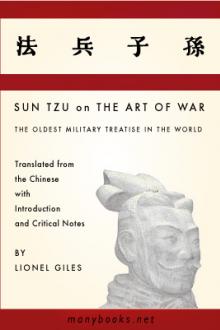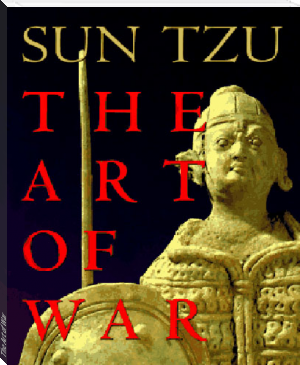The Art of War, Zi Sun [best book recommendations TXT] 📗

- Author: Zi Sun
- Performer: 0976072696
Book online «The Art of War, Zi Sun [best book recommendations TXT] 📗». Author Zi Sun
17. Therefore in chariot fighting, when ten or more chariots have been taken, those should be rewarded who took the first. Our own flags should be substituted for those of the enemy, and the chariots mingled and used in conjunction with ours. The captured soldiers should be kindly treated and kept. 18. This is called, using the conquered foe to augment one's own strength. 19. In war, then, let your great object be victory, not lengthy campaigns.
[As Ho Shih remarks: "War is not a thing to be trifled with." Sun Tzu here reiterates the main lesson which this chapter is intended to enforce."]
20. Thus it may be known that the leader of armies is the arbiter of the people's fate, the man on whom it depends whether the nation shall be in peace or in peril.
————————————————————————————————-
III. ATTACK BY STRATAGEM1. Sun Tzu said: In the practical art of war, the best thing of all is to take the enemy's country whole and intact; to shatter and destroy it is not so good. So, too, it is better to recapture an army entire than to destroy it, to capture a regiment, a detachment or a company entire than to destroy them.
[The equivalent to an army corps, according to Ssu-ma Fa, consisted nominally of 12500 men; according to Ts`ao Kung, the equivalent of a regiment contained 500 men, the equivalent to a detachment consists from any number between 100 and 500, and the equivalent of a company contains from 5 to 100 men. For the last two, however, Chang Yu gives the exact figures of 100 and 5 respectively.]
2. Hence to fight and conquer in all your battles is not supreme excellence; supreme excellence consists in breaking the enemy's resistance without fighting.
[Here again, no modern strategist but will approve the words of the old Chinese general. Moltke's greatest triumph, the capitulation of the huge French army at Sedan, was won practically without bloodshed.]
3. Thus the highest form of generalship is to balk the enemy's plans;
[Perhaps the word "balk" falls short of expressing the full force of the Chinese word, which implies not an attitude of defense, whereby one might be content to foil the enemy's stratagems one after another, but an active policy of counter- attack. Ho Shih puts this very clearly in his note: "When the enemy has made a plan of attack against us, we must anticipate him by delivering our own attack first."]
the next best is to prevent the junction of the enemy's forces;
[Isolating him from his allies. We must not forget that Sun Tzu, in speaking of hostilities, always has in mind the numerous states or principalities into which the China of his day was split up.]
the next in order is to attack the enemy's army in the field;
[When he is already at full strength.]
and the worst policy of all is to besiege walled cities.
4. The rule is, not to besiege walled cities if it can possibly be avoided.
[Another sound piece of military theory. Had the Boers acted upon it in 1899, and refrained from dissipating their strength before Kimberley, Mafeking, or even Ladysmith, it is more than probable that they would have been masters of the situation before the British were ready seriously to oppose them.]
The preparation of mantlets, movable shelters, and various implements of war, will take up three whole months;
[It is not quite clear what the Chinese word, here translated as "mantlets", described. Ts`ao Kung simply defines them as "large shields," but we get a better idea of them from Li Ch`uan, who says they were to protect the heads of those who were assaulting the city walls at close quarters. This seems to suggest a sort of Roman TESTUDO, ready made. Tu Mu says they were wheeled vehicles used in repelling attacks, but this is denied by Ch`en Hao. See supra II. 14. The name is also applied to turrets on city walls. Of the "movable shelters" we get a fairly clear description from several commentators. They were wooden missile-proof structures on four wheels, propelled from within, covered over with raw hides, and used in sieges to convey parties of men to and from the walls, for the purpose of filling up the encircling moat with earth. Tu Mu adds that they are now called "wooden donkeys."]
and the piling up of mounds over against the walls will take three months more.
[These were great mounds or ramparts of earth heaped up to the level of the enemy's walls in order to discover the weak points in the defense, and also to destroy the fortified turrets mentioned in the preceding note.]
5. The general, unable to control his irritation, will launch his men to the assault like swarming ants,
[This vivid simile of Ts`ao Kung is taken from the spectacle of an army of ants climbing a wall. The meaning is that the general, losing patience at the long delay, may make a premature attempt to storm the place before his engines of war are ready.]
with the result that one-third of his men are slain, while the town





Comments (0)